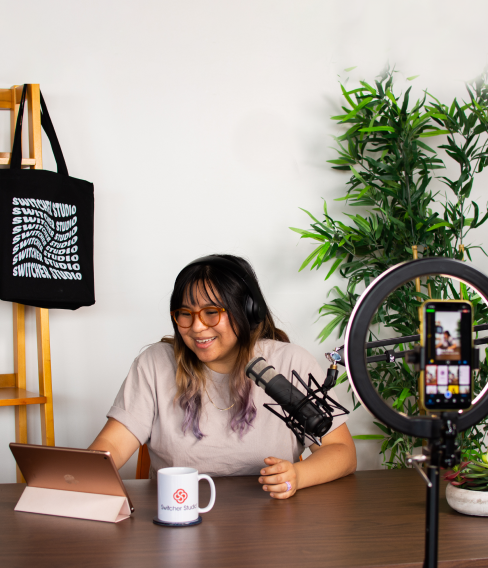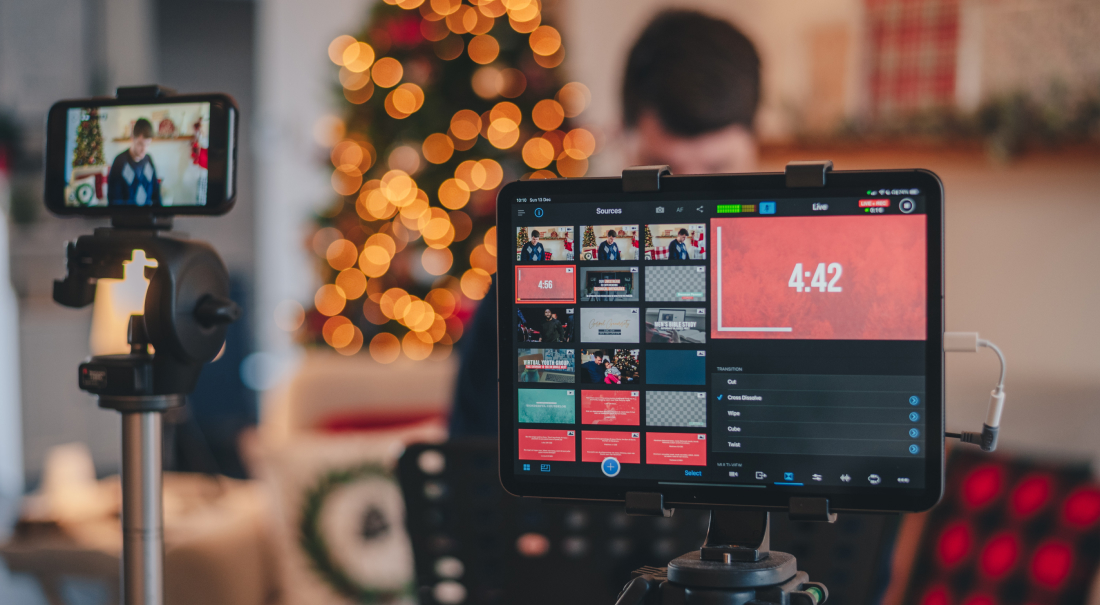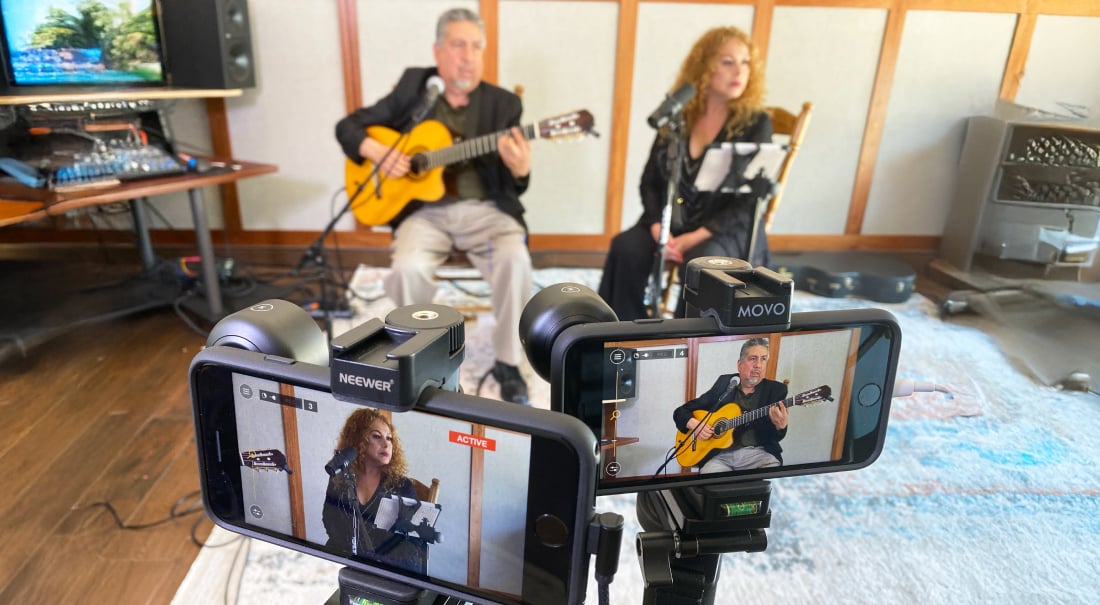
If you’re thinking about starting a video podcast, do it.
Right now, 4 out of 10 people prefer video podcasts to audio, and that number will only grow. Why? Because body language and facial expressions play a huge role in how we understand and relate to each other.
In this article, we’ll explain what makes a good video podcast recording software and how to choose the right one for you. Plus, we’ll detail 5 video podcast recording software options to help you choose wisely.
What is a video podcast recording software
Video podcasting software is a tool you can use to record, edit, produce, and publish a video podcast. They can range from easy-to-use mobile apps where you can use your phone to record, to advanced and complicated setups requiring specialized hardware.
12 Features to look for in video podcast recording software
Before you choose a podcasting software, create a checklist of all the features you need. Some features are absolutely essential, like high-quality video recording. Others may be optional, depending on your podcast’s goals and style.

Here’s a walkthrough of what to look for in a video podcasting software:
1. High-quality video and audio
Good quality recording helps your audience feel connected and more likely to tune in to your next episodes.
Look for high resolution video and audio, and local recording straight to your device so you can have full control over your recording output.
2. Multi-camera recording
When you host guests or speakers on your video podcast, multi-camera recording captures each voice and camera separately. This makes editing easier. For example, you can fix one guest’s background noise or adjust their volume without affecting others’.
3. Remote guest support
You want software that makes inviting guests quick and easy. Look for a solution that generates simple invite links so your guests can join with just a click from any browser or phone.
4. Video and audio editing tools
Basic post production video editing lets you crop, resize, add captions, and switch camera angles, which is crucial for producing polished episodes. With audio editing tools you can trim out awkward pauses, remove background noise, and sync audio with video.
Some tools even allow live editing, which means you can make changes to your podcast’s video and audio while you’re recording or live streaming.
5. Multi-camera support
Instead of one static shot, you can switch between cameras capturing different speakers, zoom in for close-ups, and pull back for wider shots. Multiple camera angles keep your viewers interested and engaged.

6. Live streaming integration
If you’re interested in live streaming, then look for a multistreaming software that helps you share your video stream to multiple platforms at once such as Facebook, YouTube, and TikTok.
7. Social media clipping and sharing
If you’re going to share clips and highlights of your video podcast on social media (and we really hope you do) look for video podcast recording software that helps you create social media clips, and allows you to share those clips directly to your social channels so you don’t have to do it manually.
8. Auto save on the cloud
It goes without saying that you don’t want to spend time recording and editing only to lose all your work because you didn’t save it. Nobody has time for that. Good video podcast recording tools autosaves your work periodically to keep it safe.
9. Embedding
Embedding means you can take your video podcast episodes and place them directly onto your website or blog. This keeps your audience on your own platform and gives you an easy way to showcase your episodes.
10. Brand customization
Choose video podcast software that lets you customize your show with graphics, logos, and colors. This helps you create a consistent, polished look that makes your podcast recognizable to your viewers.

11. Monetization
Monetization can help you turn your podcast into a source of income. Some tools include built-in features for ad insertion, donations, subscriptions, pay-per-view, and ticket sales.
12. Interactivity
If you want to interact with your viewers live, your video podcasting software should give you the tools to. Look for live chat, live Q&A, call-ins, and real time emoji features.
How to choose the right podcast recording software
There are plenty of video podcast recording software to choose from. Here’s our advice on finding the perfect fit:
-
Don’t be wooed by bells and whistles: Focus on features that matter most to you. Start with what you actually need for your podcast before chasing fancy extras that might complicate your workflow without adding much value.
-
You have to love using the software: Choose software that you enjoy working with. When the interface feels natural and the process flows easily, you’re more likely to stick with it and produce consistently.
-
Take advantage of free trials: Make a short list of the tools you’re contemplating and try before you buy! Most video podcasting tools offer free trials so you can test them firsthand before you invest in paid subscriptions.
5 of the best video podcast recording software
Here’s a roundup of our top picks. Each one of these could be right or wrong for you based on your circumstances and what you need. We’ll list their features, why we love them, and their drawbacks.
1. Switcher Studio
Switcher Studio is a neat, robust video podcast recording software that turns your iPhone or tablet into a professional live streaming and recording studio.
Switcher Studio video podcast recording standout features
-
Record crystal clear video and audio. Switcher uses your iPhone or iPad to capture sharp, smooth HD video and crisp audio. No fancy gear needed.
-
Record separate tracks for everyone (multitrack recording). Each device acts like its own video and audio track, giving you plenty of editing flexibility later.
-
Stream everywhere at once. Go live on up to 20 platforms at once.
-
Manage guests with simple invite links and easy browser access.
-
Share or record your screen for presentations and more.
-
Edit live or post production: Add your logo, titles, overlays, or text live while recording. Afterward, you can trim clips, add captions, or repurpose moments right inside Switcher’s editor.
-
Share to your socials directly from the app: Switcher lets you cut, customize, and share clips right in the editor.
-
Engage with your viewers: Talk back to your viewers with chat, polls, and emojis.
-
Autosave your work on the cloud: Everything you shoot is automatically saved.
-
Embed anywhere: Display your video podcast on your website with Switcher’s clean, ad-free player.
-
Monetize your content: Sell tickets to live events, offer subscriptions, or set up gated bonus content.
What we love
-
Intuitive user experience, easy to navigate and learn
-
Pro features made simple
-
Top tier customer support
Drawbacks
-
Monetization features are available only to Switcher Suite users
-
iOS only, not available on Android devices
2. Boomcaster
Boomcaster is a straightforward video podcast tool that records local, high-quality video from up to 6 cameras. It covers the essentials for recording and streaming and integrates with most hosting and publishing platforms.
Boomcaster standout features
-
Live show scheduling: Built-in calendar and session scheduling tools.
-
Automatic transcription: Real-time captions and editable transcripts in multiple languages.
-
Screen sharing: Share your screen during recordings or live streams for demos and presentations.
What we love
-
Producer mode lets someone join the session behind the scenes to adjust audio levels, mute guests, add graphics, spotlight speakers, and troubleshoot issues without interrupting the conversation.
Boomcaster drawbacks
-
You may need external software if you want to edit beyond the basics.
-
Occasional transcription inaccuracies.
3. Riverside
Riverside is a browser-based video podcasting and live streaming software that captures high quality local audio and video recording. It supports up to 8 participants and delivers 4K video and uncompressed audio files for podcasters interested in professional grade big production.
Riverside standout features
-
Automatic audio cleanup: Riverside sweeps through your audio to remove filler words, awkward pauses, background noise, and other distractions.
-
Text-based editing: You can edit your videos the same way you’d edit a document. Just tweak the transcript and it adjusts the audio and video for you.
-
Built-in teleprompter: Keep your script right on screen during recording.
-
Call-ins and live audience: Viewers can call into your show.
-
Async recording: Guests can record their parts on their own time via an app or browser and upload them to be joined.
What we love
-
You can export your sessions in various audio and video formats like MP4 and MOV, and adjust the aspect ratios to suit different publishing platforms.
Drawbacks
-
Some cool tools like Live Studio and advanced branding are add-ons and cost extra.
-
Long recordings sometimes face audio-video sync issues
4. Descript

Descript offers 4K video capture with separate multitrack recording for audio and video, automatic real time transcripts, and support for editing multiple video and audio tracks.
Descript standout features
-
Screen recording: You can capture your entire screen, a specific window, or a portion of it while also recording audio from your microphone, which comes in handy for tutorials and walk-throughs.
-
Overdub voice cloning: You can train Descript to mimic your voice, then type in what you want said, and it creates a voice clip in your voice that you can use to correct mistakes without re-recording.
-
Collaboration tools: Descript lets your team comment on your project, make edits together in real time, and track the revision history.
What we love
-
Descript automatically enhances your sound by reducing background noise, echo, and other distractions.
Drawbacks:
-
Learning to edit in Descript is a steep curve.
-
Filler word removal can confuse normal words with filler, which can cause audio and transcriptions problems.
5. Streamyard

StreamYard is a video podcasting platform that offers local audio and video recordings. The platform includes studio-quality audio options such as echo cancellation and background noise removal.
Standout features
-
Pausable scrolling: Viewers can stop the chat from moving which makes it easier to engage without feeling rushed.
-
Audio library: 15 free sound effects right inside the studio, including applause, laugh tracks, gongs, and more. These sounds can be triggered during live streams or recordings. There’s also an option to upload custom audio files like branded sounds or jingles.
What we love
-
Portrait mode with full scene functionality for vertical streaming on mobile platforms like Instagram Live and TikTok.
Drawbacks
- No built-in editing tools: You’ll need separate software to edit recorded files.
- Branding and screen layout options are basic.
Create your video podcast with Switcher today
With Switcher Studio, you can easily produce professional-quality video podcasts using only your iPad and iPhones.
Try Switcher Studio today and see why it’s the top choice for podcasters who want to hit the ground running.
Subscribe to the blog
Sign up to receive notifications whenever a new blog post is published. You may unsubscribe at any time.



